| Article ID | Journal | Published Year | Pages | File Type |
|---|---|---|---|---|
| 265583 | Energy and Buildings | 2007 | 12 Pages |
The issues of comfort and workspace quality in buildings have gained much importance with the European “Energy Performance of Buildings Directive” of 2001. New energy efficient building concepts and technologies require a revision of comfort standards, which were developed for air-conditioned buildings only. Particularly, the question of recommendable upper indoor temperature limits needs further investigation. In addition, a broader approach to occupant satisfaction in buildings is necessary with respect to overall building performance.The results of a 4-week summer field study on thermal comfort with 50 subjects in a naturally ventilated office building in Karlsruhe, Germany, show that thermal sensation votes do not correspond to calculated predicted mean votes, but a very good agreement can be seen with adaptive comfort models. The dependence between thermal comfort and the outdoor temperature in naturally ventilated buildings could therefore be confirmed.A survey on workplace occupant satisfaction in 16 office buildings in Germany revealed that the occupants’ control of the indoor climate and moreover the perceived effect of their intervention strongly influence their satisfaction with thermal indoor conditions.The paper also introduces a method for assessing the building performance by occupant surveys calculating the weighted importance of every satisfaction parameter in relation to the general acceptance of the workplace and then ranking the different satisfaction parameters.
